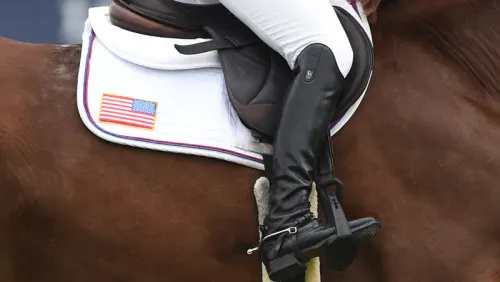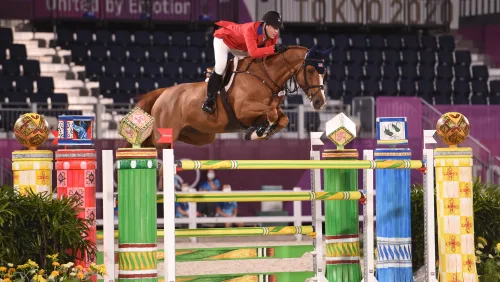Beezie Madden started her gymnastics session Saturday—Day 2 of the USEF 2025 Horsemastership Training Series, held Jan. 2-5 in Wellington, Florida—with a fundamental lesson: the importance of properly mounting your horse.
“I like to keep my outside rein a little tighter than the inside because I have control if he wants to go in any direction,” the four-time Olympian said as she mounted her 8-year-old gelding Micky-Cara. “I put my foot in the stirrup and keep it by the girth. I want my right hand up by the pommel so I don’t have to move it to get on. A lot of people put their hand on the back of the cantle or in the middle, but it’s best to put it on the pommel.”
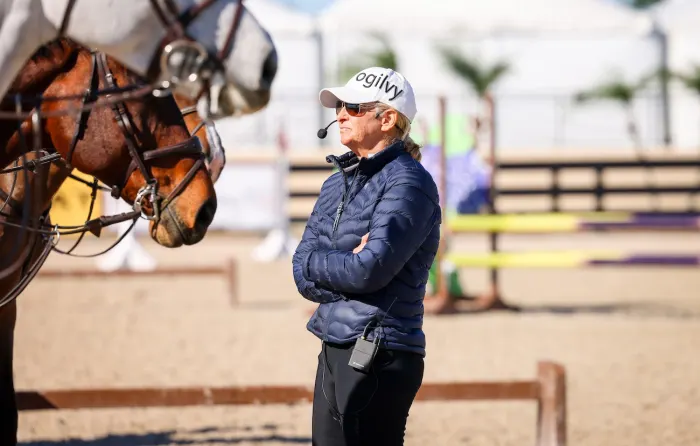
Madden began her warm-up by addressing the importance of an effective position and a relaxed body.
“Position is not because I want to look pretty, but because I want to be effective and be able to communicate with the horse in the most effective way with the least amount of distractions for him,” Madden said.
Continuing her focus on effective communication, Madden demonstrated how to find the correct leg position. She shifted into her two-point position, beginning to bounce gently to lower her leg smoothly around the horse’s side. As she settled into the front of her saddle, she kept her lower leg steady, maintaining a secure yet relaxed contact.
The gymnastics course was designed to develop rhythm, balance and precision in both horse and rider.
The riders began with three cavaletti placed on the center line, set 60′ apart. Riders approached the exercise in various ways, adjusting the stride length each time to challenge their timing and control.
On one long side, a line was set at 74′, intended to be ridden in a quiet six strides or a forward five. Both jumps were square oxers with no ground rails and could be jumped in either direction, with one featuring a liverpool underneath.
ADVERTISEMENT

On the opposite long side, a line of four jumps was set at 34’6” inches between each element, designed to be ridden in two strides.
At the end of the ring was a bending line of three jumps, each at a height of 18“. This exercise was designed to be ridden as a normal one-stride to one-stride. It helped riders focus on controlling their horses while encouraging them to think about landing on the correct lead.
Before warming up, Madden had the riders demonstrate their two-point position at the walk and trot to ensure their legs were properly underneath them. Madden summoned Avery Griffin for a demonstration of the two-point position. Madden pulled Griffin’s leg forward toward the horse’s head, causing Griffin to lose her balance and fall out of position, demonstrating how crucial it is for the rider’s leg to stay directly underneath them to maintain balance and stability.
Once the riders warmed up their horses, they began the first exercise, jumping the three cavaletti. They started by riding the line in a forward four strides to four strides. Then, they adjusted to five strides to five strides, followed by five strides to four strides, and then four strides to five strides. The exercise continued with six strides to four strides and finally, four strides to six strides.

“I’ve never been the most talented rider, but I work hard at making my horses adjustable,” Madden said modestly. “If I don’t see it eight or nine strides out like you like to see it, I have to be able to adjust my horse three, four and five strides out, and it’s the same in the lines. By the end of this, I can do three and five, even in that shorter distance, with all my horses. The horses have to be adjustable, and they have to be there for you when you call on them. Horses make you look like good riders when they’re adjustable.”
The riders moved on to jumping the bending line in the corner of the ring. They cantered into the line, completing the sequence, then transitioned down to a trot before picking up the canter again. They then rolled back to a vertical set on the diagonal, then continued to the corner jumps, ridden in the opposite direction. The exercise was repeated with another transition from trot to canter, followed by a rollback to a square oxer set on the opposite diagonal. To finish, the riders jumped the corner jumps once again, focusing on maintaining fluidity and control throughout the course.
“Ask with a little pressure, release with a little light contact,” Madden said of the downward transitions. “If they get a little release, they’re going to be quicker to do it right. If they know you’re going to keep pulling, they’re going to fight you. Carry the hands and then make it a soft hand. It can just be finger contact.”
The next exercise focused on the liverpool line. The first time around, Madden had the riders focus solely on jumping the liverpool to help the horses become comfortable with the obstacle. To make the exercise more approachable, she lowered rails of the oxer to make an “X.” Madden encouraged the riders to ride forward, making sure they were helping their horses approach with confidence.
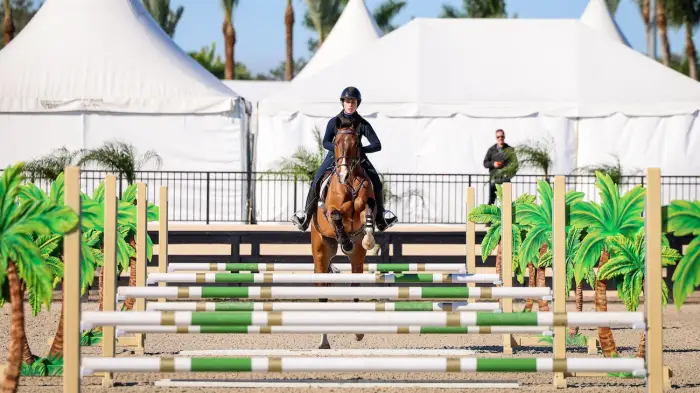
Madden then had the riders tackle the whole line in a forward five strides. After each jump, Madden instructed the riders to transition to walk before approaching the corner, where she emphasized the importance of “pressure and release.” She explained that applying pressure with subtle cues and immediately releasing when the horse responded correctly helped reinforce desired behavior while maintaining softness and connection throughout the ride.
ADVERTISEMENT
Madden then had the riders do the same exercise in a quiet six strides, encouraging the horses to gather themselves and power over the oxer out of the line.
The first time trying the six-stride off the left lead, Taylor Cawley and her horse Quatro Van Dorperheide knocked the back rail of the liverpool.
“Do it again, and we’ll see if he learned from that. He might want to help you a little more there,” Madden said. “We’re not looking to have horses hit the fences, but if they hit the fences because they didn’t listen, then maybe that’s a learning experience for them.”
The next attempt went more smoothly, as Cawley’s horse wasn’t running through her hands as much, and the transitions to the trot had helped him stay more balanced and focused. He was also more careful over the liverpool, showing improved attention.
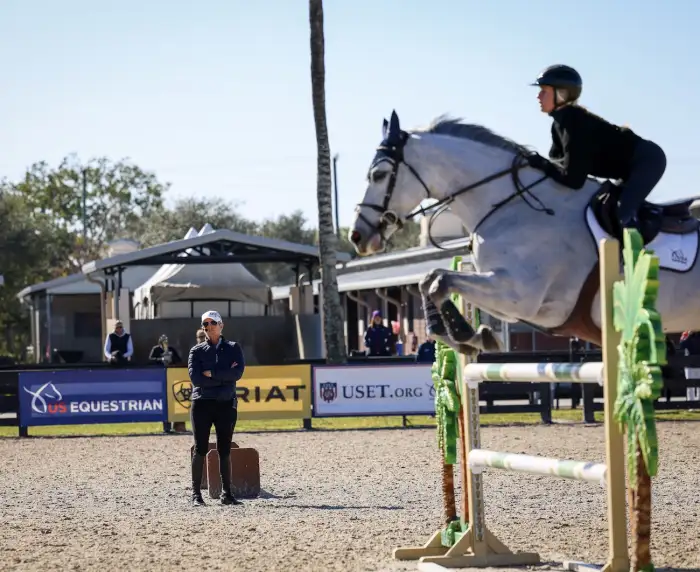
The last exercise, focusing on the four-part line, was quite successful. The main goal of the exercise was to avoid micromanaging and allow the horses to focus on doing the work themselves. Madden encouraged the riders to trust their horses’ ability to handle the line and maintain a natural rhythm. She reminded them to give the horses space to think while still maintaining balance and control.
“A lot of times we get very mechanical in our riding, like shoulder-in, which is right indirect rein and right leg, but it’s also feeling what the horse is doing, and if he’s doing it, then release a little and say, ‘Yes, that’s the right thing,’ ” Madden said. “The same thing with going back to the trot or the walk. You want to be prompt, but you want to do it with connection and balance.”
ClipMyHorse.tv premium members can watch all the USEF Horsemastership sessions via USEF Network.
The three-day USEF Horsemastership Training Series also included a Friday flatwork session taught by Anne Kursinski and will conclude with a jumping session taught by McLain Ward on Sunday.







